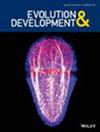From deep roots to new blooms: The ever-growing field of evo–devo across land plants
IF 2.6
3区 生物学
Q2 DEVELOPMENTAL BIOLOGY
引用次数: 0
Abstract
At its core, the field of evolutionary developmental biology aims to understand how morphological innovations arise. Do new structures require new toolkits or can they be made by tweaking existing ones (Brakefield, 2011; Della Pina et al., 2014)? Are certain loci or types of mutations more likely to contribute to phenotypic evolution (Sobel & Streisfeld, 2013; Stern & Orgogozo, 2008)? To what degree do convergently evolved traits rely on the same underlying mechanisms and can we predict when such molecular and developmental convergence is likely to occur (Martin & Orgogozo, 2013)? Addressing these questions requires a comparative approach, from the studies of sister taxa where trait divergence has recently occurred to comparisons across entire phyla to understand features that only vary at the deepest scales. Botany has a long history of comparative developmental research (Endress et al., 2000), and placing this line of research in the context of the fossil record has built an increasingly clear picture of major innovations spread across the plant phylogeny (Harrison, 2017; Rothwell et al., 2014). One perhaps surprising theme that has emerged from our growing understanding of plant evolutionary history is the degree to which major innovations have evolved multiple times. For example, leaves and roots independently evolved in the lycophytes (club mosses and allies) and the euphyllophytes (ferns and seed plants) (Spencer et al., 2021). Similarly, colorful fleshy structures surrounding seeds to enhance dispersal have evolved in both gymnosperms and in angiosperms (Di Stilio & Ickert‐Bond, 2021; Figure 1). These striking instances of convergent evolution raise the question of whether these repeated innovations drew from conserved mechanisms, present in the common ancestors of these lineages hundreds of millions of years in the past. Probing the possibility of such deep homology (Shubin et al., 2009) has become an important focus for plant evo‐devo research and led to significant efforts to develop genomic resources and molecular tools across diverse plant lineages. As study organisms, plants present some exceptional benefits, such as the ease of clonal propagation, the ability to self‐fertilize (in some taxa), the large numbers of offspring (in some taxa), and the wide crossability among species, often spanning different genera. Nevertheless, studying plant diversity beyond Arabidopsis frequently means overcoming a range of technical and computational challenges, from developing species‐specific tissue culture and regeneration for transformation to assembling large, repetitive and/or highly heterozygous genomes. Indeed, the cells of the monocot Paris japonica are stuffed with the largest known eukaryotic genome, a 149 Gb goliath that is roughly 50 times the size of the human genome (Pellicer et al., 2010). Despite these challenges, comparative research in plant developmental biology promises new insights into a range of longstanding areas of interest in evo‐ devo, including how pathways arise and become rewired over evolutionary time as new structures emerge, and how development is evolutionarily fine‐ tuned as species diverge. Discoveries from plant evo–devo not only illuminate these basic questions but contribute to important advances in applied research in agriculture, horticulture and even medicine (Davies et al., 2012; Doebley et al., 2006; Gershlak et al., 2017; Lemmon et al., 2018). This special issue highlights recent advances emerging from taxa across the plant tree of life as well as the prospects for new discoveries in the years to come.从深根到新花:不断增长的进化- devo领域跨越陆地植物
本文章由计算机程序翻译,如有差异,请以英文原文为准。
求助全文
约1分钟内获得全文
求助全文
来源期刊

Evolution & Development
生物-发育生物学
CiteScore
6.30
自引率
3.40%
发文量
26
审稿时长
>12 weeks
期刊介绍:
Evolution & Development serves as a voice for the rapidly growing research community at the interface of evolutionary and developmental biology. The exciting re-integration of these two fields, after almost a century''s separation, holds much promise as the focus of a broader synthesis of biological thought. Evolution & Development publishes works that address the evolution/development interface from a diversity of angles. The journal welcomes papers from paleontologists, population biologists, developmental biologists, and molecular biologists, but also encourages submissions from professionals in other fields where relevant research is being carried out, from mathematics to the history and philosophy of science.
 求助内容:
求助内容: 应助结果提醒方式:
应助结果提醒方式:


